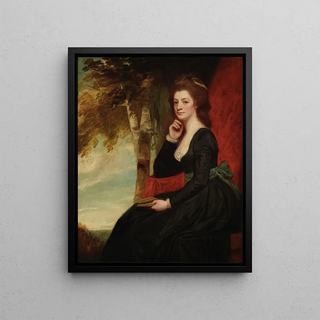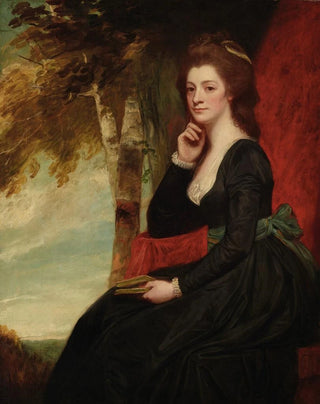Art print | Portrait of a lady traditionally identified as Anne, Countess of Clare - George Romney


View from behind

Frame (optional)
In the fascinating world of art, some works manage to capture the very essence of their era while transcending time. The "Art print of a lady traditionally identified as Anne, Countess of Clare" by George Romney is one of those creations that evoke timeless beauty. Created in the late 18th century, this portrait stands out for its ability to evoke a deep intimacy between the viewer and the subject. The delicacy of the features, the depth of the eyes, and the elegance of the clothing testify to exceptional technical mastery, while offering a glimpse into the aristocratic life of the period.
Style and uniqueness of the work
George Romney's style is characterized by a blend of realism and romanticism, where every detail is carefully considered to convey not only the physical appearance but also the soul of the subject. In this portrait, the Countess of Clare is depicted with rare grace, her delicate features and pensive expression creating a palpable emotional connection. The chosen colors, soft and harmonious, enhance the luminosity of the face and the richness of the fabrics surrounding her. The composition is balanced, highlighting the lady's posture while subtly integrating elements of her environment. This combination of technical virtuosity and artistic sensitivity gives the work a depth that invites contemplation.
The artist and his influence
George Romney, born in 1734, is one of the most renowned portraitists of his time. His training in London and his varied influences, ranging from old masters to contemporary artists, shaped his distinctive style. Romney was able to capture the spirit of his era by painting emblematic figures of British high society. His work not only influenced his contemporaries but also continues to inspire subsequent generations of artists. The way he combined impeccable technique with emotional sensitivity made him a pioneer in the field of portraiture. The "Art print of a lady traditionally identified as Anne, Countess of Clare" is a perfect example of this fusion of technique and emotion, bearing witness to the artist's lasting legacy.

Matte finish

View from behind

Frame (optional)
In the fascinating world of art, some works manage to capture the very essence of their era while transcending time. The "Art print of a lady traditionally identified as Anne, Countess of Clare" by George Romney is one of those creations that evoke timeless beauty. Created in the late 18th century, this portrait stands out for its ability to evoke a deep intimacy between the viewer and the subject. The delicacy of the features, the depth of the eyes, and the elegance of the clothing testify to exceptional technical mastery, while offering a glimpse into the aristocratic life of the period.
Style and uniqueness of the work
George Romney's style is characterized by a blend of realism and romanticism, where every detail is carefully considered to convey not only the physical appearance but also the soul of the subject. In this portrait, the Countess of Clare is depicted with rare grace, her delicate features and pensive expression creating a palpable emotional connection. The chosen colors, soft and harmonious, enhance the luminosity of the face and the richness of the fabrics surrounding her. The composition is balanced, highlighting the lady's posture while subtly integrating elements of her environment. This combination of technical virtuosity and artistic sensitivity gives the work a depth that invites contemplation.
The artist and his influence
George Romney, born in 1734, is one of the most renowned portraitists of his time. His training in London and his varied influences, ranging from old masters to contemporary artists, shaped his distinctive style. Romney was able to capture the spirit of his era by painting emblematic figures of British high society. His work not only influenced his contemporaries but also continues to inspire subsequent generations of artists. The way he combined impeccable technique with emotional sensitivity made him a pioneer in the field of portraiture. The "Art print of a lady traditionally identified as Anne, Countess of Clare" is a perfect example of this fusion of technique and emotion, bearing witness to the artist's lasting legacy.






